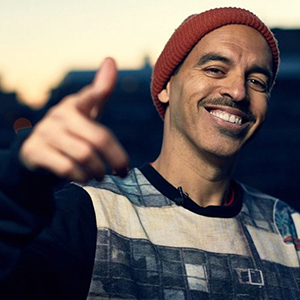Movies
Review: 'Rock Rubber 45s'
 Robert 'Bobbito' Garcia tells his story, in his words—with a little help from his celebrity friends—in 'Rock Rubber 45s,' which is screening at this year's San Jose Jazz Summer Fest.
Robert 'Bobbito' Garcia tells his story, in his words—with a little help from his celebrity friends—in 'Rock Rubber 45s,' which is screening at this year's San Jose Jazz Summer Fest.There is, or used to be, a profession called "coolhunting." It described people who went out to the field to try to corral the next upcoming trend. For the multi-multi hyphenate Robert "Bobbito" Garcia, the coolness seems to have found him.
Garcia's autobiographical documentary Rock Rubber 45s is a delight—this 50-something man of many talents is a born ambassador. Despite the numerous testimonials here—including one from Hamilton creator Lin-Manuel Miranda, who tells Bobito "You encapsulate NY as a part of who you are"—Rock Rubber 45s never seems like a mere commercial for the director. By following his personal obsessions, which include hip-hop, hoops, customized sneakers, journalism and filmmaking, Garcia both chronicled and spread what was a regional NYC culture to the rest of the world.
Garcia—lean, male-pattern bald and mustached—is an engaging spokesman. He's completely without that iron mask that people who come out of tough neighborhoods tend to wear. No surprise to hear that his college nickname was "Nice" Garcia. He stopped answering to that after he encountered Pete Nice of the band 3rd Bass—after that, Garcia had the handle "Cucumber Slice."
Born in Puerto Rico, Garcia came to New York before he was old enough to learn Spanish. His father was a musician and, after he came to America, a ruinous drinker; his mother was a woman of all trades, from cosmetology to Wall Street trading. Bobbito was bullied—"I got so used to being smacked that I'd hit myself"—and worse.
He was aided by a program that sent him to school in the Philadelphia Main Line, where he was given mentoring and home cooked meals from singer Patti Labelle. Then to Wesleyan, where he more or less majored in junior varsity basketball. He never broke out on the top squad—a clue is that coaches at the time tended to worry about the unruliness of vets of NYC street basketball. Garcia played on the Puerto Rican national team, but came back to New York.
His post-college career led him from counterwork at the bone boutique Maxilla and Mandible (or 'All Things Dead' as Steve Martin called it). This led to DJing with his colleague Stretch Armstrong and to the A&R department at the nascent Def Jam records. Then came a job with Quincy Jones' Vibe magazine, which he left because of disdain for the Top 40 music the once-underground magazine sought to push.
In the 1990s, Garcia opened the very first boutique for athletic shoes. He lost $60,000. Promotional work with Nike made him seek a way to funnel money to charities in Africa, while he documented the shoe styles in his book Where'd You Get Those? And, on TV interviewing everyone from Michael Jordan to Spike Lee. Lee jokes that he and his friends always called off-brand sneakers "MOs'"—short for "M-O-tations."
Rock Rubber 45s' last third is a non stop string of triumphs as Garcia turned to filmmaking. The wrap-up includes celebrity endorsement (Garcia's international Stevie Wonder dance parties heated up further with visits from Wonder). His dear pal, the dancer and actress Rosie Perez, reminisces about her and Garcia's times together at APT, the groundbreaking Meatpacking district dance club where Garcia DJ'd.
The style is brisk but not exhaustingly busy—it doesn't burn the viewer out. Since it's filmed in a city where careerism is paramount, Garcia's career suicides and seemingly effortless resurrections are absolutely inspirational.
Rock Rubber 45s
Aug 10, 7pm
SJMA Next Gen Stage


